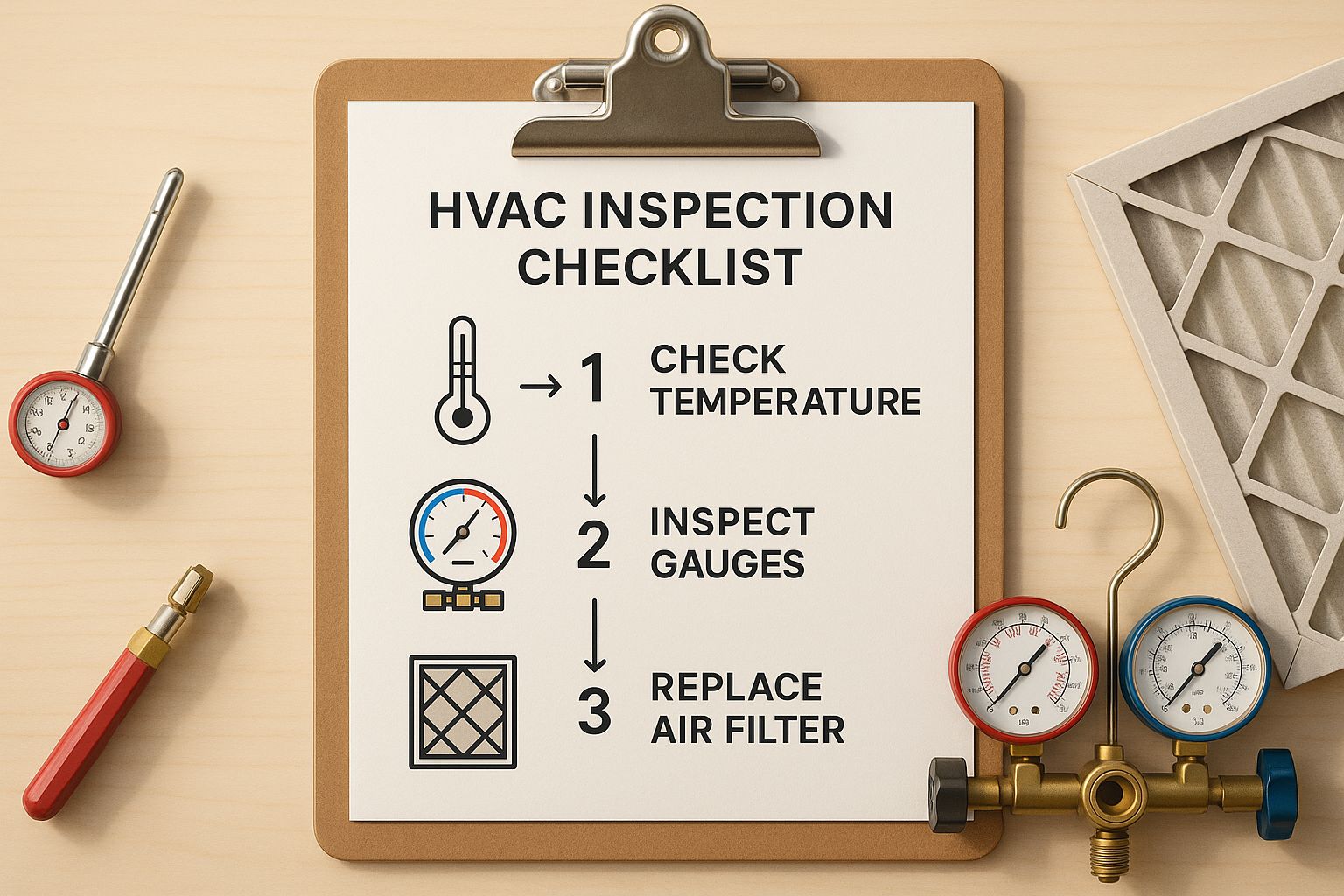An HVAC service report template isn't just another piece of paperwork. Think of it as a strategic tool that documents every job, backs up your recommendations, and, most importantly, builds rock-solid trust with your clients. A well-designed report smooths out communication between your techs, the office, and your customers, creating a transparent and professional experience that protects your business and cuts down on frustrating callbacks.
Why Your HVAC Business Needs a Smarter Service Report
For any HVAC business looking to grow, moving past basic, scribbled notes is non-negotiable. A thoughtfully designed HVAC service report stops being an administrative headache and becomes a genuine business asset. It has a direct impact on how clients see you, how efficient your techs are, and even gives you a layer of legal protection.
Picture this: a customer calls to dispute the work you did on their last maintenance visit. If all you have is a simple invoice, it's your word against theirs. But with a detailed report showing pre-service system readings, a clear checklist of completed tasks, and post-service measurements, you have undeniable proof of the value you delivered. It’s your best defense against misunderstandings.
From Chore to Strategic Asset
It works the other way, too. When a technician has to recommend a major system upgrade, a service report filled with data-backed observations—like a steady decline in energy efficiency or recurring refrigerant pressure problems—justifies the cost. Suddenly, it’s not a sales pitch. It’s a professional consultation that empowers the customer to make a smart, informed decision.
A properly structured HVAC service report is more than just a record; it becomes a key part of your company's modern quality assurance processes. It ensures that every single customer gets the same high standard of service and documentation, no matter which technician shows up at their door.
A detailed report reframes your service from a simple transaction to a professional assessment. It demonstrates expertise and builds the long-term trust necessary for repeat business and valuable referrals.
This level of professional documentation is becoming crucial. The global HVAC market, valued at around USD 241.52 billion in 2024, is expected to explode to USD 505.73 billion by 2035. This massive growth is driven by increasing urbanization and the push for energy-efficient systems. Meticulous records are essential to track system performance and meet new sustainability goals. You can dig deeper into these trends by reading the full analysis of the global HVAC market growth on Spherical Insights.
By putting a smarter report in place, you’re setting up your business to not just survive but thrive in this growing market, all while reducing callbacks and boosting your bottom line.
The Essential Anatomy of an HVAC Service Report

A truly effective HVAC service report is much more than a simple checklist. It's the complete story of a service call, from the moment your tech walks in the door to the final handshake. Each part has a specific job, and when they all come together, you get a document that’s clear, easy to defend, and genuinely useful for both your team and your customer. If you start skipping sections, you’re just asking for confusion, disputes, and missed opportunities down the road.
Let's walk through the non-negotiable elements that make up a professional report. Think of these as the fundamental building blocks you'll need to create a template that actually works in the field.
Foundational Job and Client Details
Before you even get to the technical stuff, your report has to nail down the who, what, where, and when. This might sound obvious, but getting these details right from the start prevents some major headaches later on.
- Customer Information: Don't just settle for a name. You need the service address, the billing address (if it’s different), a primary phone number, and an email. Having multiple ways to get in touch is a lifesaver; if a tech can't reach the main contact, that backup number can prevent a completely wasted trip.
- Technician and Company Info: Always include the assigned technician's name and ID number. This simple step establishes accountability and gives the office—and the customer—a clear point of contact for any follow-up questions.
- Date and Time: You absolutely must document the service date, arrival time, and departure time. This information is your best friend when it comes to accurate billing, job costing, and shutting down any potential arguments about how much time was spent on site.
Equipment and System Vitals
This is where the technical narrative really begins. Identifying the equipment precisely and taking baseline measurements are critical for good diagnostics and tracking the system's health over time. A vague note like "the AC unit" just won't cut it.
You have to capture the equipment type (is it a split system, a rooftop unit, or a furnace?), the brand, the model number, and the serial number. These details are everything when it comes to ordering the right parts and checking on warranty status. Without them, what should be a quick parts order can easily turn into a multi-day delay that leaves your customer fuming.
Your report should paint a clear "before and after" picture. Documenting the system's condition upon arrival—both visually and with initial readings—provides a baseline that justifies the work performed and proves the value of your service.
The documentation from these reports is a cornerstone of the massive HVAC industry. For context, in 2023, the global sector reached revenues of about USD 255.1 billion, with the U.S. market alone accounting for USD 123 billion. With growing urbanization and tougher energy rules, these reports are absolutely critical for tracking equipment efficiency and justifying maintenance. You can find more details in this analysis of HVAC market performance.
Documenting the Work and Findings
Okay, now we're getting to the heart of it. This section details exactly what your technician did and what they found. It’s the core evidence of the service you provided.
A well-structured report breaks this information down into clear, digestible categories. It ensures nothing gets missed and makes it easy for anyone—the customer, the office manager, or another tech—to understand the situation at a glance.
Here is a breakdown of the key information that must be included in a professional report to ensure clarity and customer satisfaction.
Key Sections of an Effective HVAC Service Report Template
Ultimately, this part of the report tells the story of the value you delivered. From diagnosing the initial problem to listing the specific parts used, every detail builds a case for your professionalism and expertise. It moves the conversation from "What did you do?" to "Here's exactly what we did and why it matters."
Designing a Template Your Techs Will Actually Use
Let's be honest. You can create the most detailed, comprehensive HVAC report in the world, but it’s completely useless if your technicians hate filling it out. The real goal here is to build something that’s actually faster for them to use than scribbling on a notepad. If it feels like a bureaucratic chore, you’ll get rushed, incomplete information back from the field, which defeats the whole purpose.
The secret is designing for speed and clarity. Think about the reality of the job site: your tech is probably on a tablet or phone, often in a cramped, poorly lit space. Forget cluttered layouts that require endless pinching and scrolling. The design needs to be clean, simple, and intuitive from the get-go.
This visual gives you a great idea of a technician's typical workflow. A good template should follow this same logical path.

From the initial once-over to the final system checks, your report's structure should be a mirror image of how a pro actually works on the equipment.
Build It for Speed and Accuracy
Every second a tech spends fighting with a clunky form is a second they aren't billing or moving to the next job. Your design choices need to make data entry as painless as possible.
Embrace Checkboxes and Drop-Downs: For routine tasks like "Checked thermostat calibration" or "Cleaned condenser coils," use simple checkboxes. This turns a whole sentence into a single tap. For parts and equipment, pre-populated drop-down menus eliminate typos and guarantee you’re using consistent terminology.
Don't Get Rid of Note Fields: While structured data is fantastic, we all know some jobs are just... weird. An experienced tech needs a place to explain the nuances. Always include a dedicated text box for "Technician's Notes" or "Observations." This is where you get the gold, like, "Noticed faint humming sound from compressor on startup, only when ambient temp is below 60F." A checkbox can't capture that.
Require Photo and Video Attachments: A picture is undeniable proof. Make it mandatory to attach photos of a corroded part, a before-and-after of a dirty filter, or the final, clean work area. It provides incredible value, justifies recommendations to the customer, and covers your company. Modern software like Jobber or ServiceTitan makes adding media dead simple.
A template's true success is measured by how quickly your team adopts it. If it doesn’t make a technician's job easier, it has failed—no matter how perfect it looks on a computer screen in the office.
Create a Logical Flow
The layout of your report needs to follow the natural order of a service call. A disorganized form forces techs to jump around, which is a recipe for missed steps and frustration.
A flow that just makes sense usually looks something like this:
- Customer & Job Info: Get the basics down first.
- Initial Assessment: What’s the customer's complaint? What did the system look like upon arrival?
- Work Performed Checklist: This is the heart of the report, detailing every task completed.
- Key Measurements & Readings: The hard data—pressures, temperatures, amperage draws.
- Recommendations & Next Steps: What did you find? What needs to happen next?
This sequence guides the technician through the paperwork, making it a natural extension of their work instead of a roadblock. It ensures all the critical information is captured, every single time.
Tailoring Your Reports for Residential and Commercial Jobs
Think about it: the needs of a homeowner are worlds apart from those of a facility manager overseeing a massive commercial property. So why would you use the same service report for both? A generic, one-size-fits-all template just doesn't cut it. Customizing your reports for these two very different markets shows you understand their unique priorities and makes your service infinitely more valuable.
This isn't just a "nice-to-have" anymore. It's a critical business move in a U.S. HVAC market valued at a staggering USD 133.7 billion in 2024. That market is carved up between residential (40%) and commercial (35%) clients, and each side has its own language and concerns. Having the right report for the job is essential for tracking everything from routine maintenance to complex compliance issues. If you want to dig deeper into the numbers, check out these HVAC market trends and strategic insights on Fieldax.
Simply put, if your paperwork doesn't adapt, you're leaving money and opportunities on the table. You'll miss key details and fail to show off the specialized expertise your clients are paying for.
Key Fields for Commercial HVAC Reports
When you're on a commercial job, you're dealing with someone managing high-value assets who lives and breathes operational standards and safety codes. Your service report needs to be a professional document that speaks their language.
- Asset Management Details: Forget "the unit on the roof." Get specific. Include fields for asset tags, precise unit locations (like "Roof, Sector 3, Unit 4B"), and which specific area it serves. This is gold for property managers trying to keep a handle on their entire equipment inventory.
- Compliance Documentation: Facility managers need proof. Add a checklist to document compliance with regulations like ASHRAE 62.1 for ventilation. This gives them a paper trail and peace of mind.
- Multi-Unit Service Logs: For sites with dozens of identical units, your tech needs an efficient way to log their work. A simple table or section lets them quickly note checks on multiple systems and only detail the ones with issues.
With these additions, your report stops being just a receipt and becomes a crucial tool for facility management.
Essential Sections for Residential Jobs
Homeowners have a completely different set of priorities. They care about comfort, their utility bills, and whether the air their family is breathing is healthy. Your report should be less of a technical manual and more of a helpful guide.
A residential report shouldn't just document a repair; it should educate the homeowner. By including information on air quality and smart home features, you position your company as a trusted home comfort advisor, not just a repair service.
Incorporate sections that prove the value you're bringing to their home. This is how you build trust and open the door for future business.
- Indoor Air Quality (IAQ) Results: If you run IAQ tests, don't just jot down numbers. Create a dedicated spot to show results for particulate matter, humidity, or VOCs, and briefly explain what they mean in plain English.
- Smart Thermostat Configuration: Homeowners often struggle with their smart thermostats. Add a field where your tech can note the exact model and the settings they configured. It’s a simple reference that clients love.
- Warranty Information Tracking: This is a small thing that makes a huge impact. Include a section to log the expiration dates for parts and labor warranties. Homeowners almost never track this themselves, and they will be grateful you did.
By taking the time to split your standard report into two focused versions—one for commercial, one for residential—you give your technicians the tools they need to deliver targeted, relevant information every time. It’s a simple change that makes your entire operation look more professional and feel more valuable to every single client.
How to Implement Your New Template and Train Your Team

So you've designed the perfect HVAC service report template. That’s a fantastic start, but it's only half the battle. A brilliant template collecting dust is just a wasted effort. The real measure of success is getting your entire team to actually use it, and use it consistently. This isn't about just dropping a new rule on them; it’s about showing your technicians how this new tool makes their day-to-day work better.
Believe it or not, the technology itself is rarely the biggest hurdle. The real challenge is getting buy-in from your crew in the field. They're the ones who will ultimately decide if this new system succeeds or fails. If they view it as just more paperwork, they'll find every reason to avoid it. The trick is to bring them into the fold early and show them how it directly benefits them.
Earning Technician Buy-In
Getting your team on board starts with making them part of the conversation. Before you roll out the final version, gather your techs and show them the draft. Ask them point-blank for their honest feedback.
You’ll get invaluable insights you might have missed. They might say things like, "I need more room here for notes on older units," or "Can we get a quick checkbox for confirming the Wi-Fi connection on a smart thermostat?" This simple act does more than improve the template; it gives your team a sense of ownership.
From there, you have to answer their unspoken question: "What's in it for me?" Frame the new report as a tool that protects them and makes their job easier.
- Fewer Arguments with Customers: When a report has before-and-after photos and hard data, it shuts down potential disputes. It's proof of the work done and the system's condition.
- Quicker Paydays: Clean digital reports that zip back to the office mean no more lost or illegible paperwork. This speeds up invoicing, which often means faster commission payouts.
- Easier Upsells: A thorough report with objective data makes it much easier to show a customer why they need an expensive repair or a full system replacement. You’re not just selling; you’re providing a professional consultation backed by evidence.
When your techs see the template as their shield—a tool that reduces headaches and supports their expertise—they'll start using it without a second thought. It stops being a burden and becomes an asset.
Conducting Effective Training
Keep your training sessions short, practical, and hands-on. Skip the long, boring PowerPoint presentation. Instead, run a live demo. Grab a tablet and walk through a mock service call, filling out the new report right there with them.
Show them exactly how to complete each section, and stress the importance of being consistent. For example, make it clear that refrigerant pressure should always be noted in PSI or that the temperature split is always recorded in Fahrenheit. This kind of consistency is what makes the data valuable for tracking equipment history down the line.
Finally, open the door for feedback and keep it open. Let your team know you'll be checking in after a week or two to see how things are going. A great service report is a living document. Being willing to make small adjustments based on real-world use is what will ensure it remains a powerful tool for your entire company.
Answering Your HVAC Service Report Questions
Even with a solid plan, questions pop up. I get it. Over the years, I’ve seen technicians and owners wrestle with the same few issues when it comes to getting their service reports just right. Let's tackle those head-on with some practical, no-nonsense advice.
What's the Single Biggest Mistake to Avoid?
Without a doubt, the most common pitfall is overcomplicating your hvac service report template. It’s so tempting to want to capture everything, but a bloated, confusing form is the fastest way to get bad information.
Picture your tech trying to navigate a complex digital form in a cramped, sweltering attic. They’re either going to start skipping fields or just punch in whatever to get it done. The whole point of the report is lost. Always choose clarity over clutter. A report that’s 80% complete but 100% accurate is infinitely more useful than a massive template that’s barely half-filled out. Simplicity breeds consistency, and that's the name of the game.
Should My Business Stick with Paper or Go Digital?
I know paper feels familiar, but for any modern HVAC business, digital is the only way to go. The advantages you gain from a digital report on a phone or tablet are just too significant to ignore.
- Instant Sharing: The second a job is done, that report can be in the customer's inbox and on the office manager's screen for invoicing. No more delays, lost slips, or trying to decipher messy handwriting.
- Photo Evidence: This is a game-changer. A tech can snap a quick photo of a corroded contactor or a cracked heat exchanger. It’s undeniable proof that builds instant trust and validates their findings.
- Direct Integration: Digital reports can automatically sync with your CRM or FSM software, building a rich service history for every client and every piece of equipment without anyone lifting a finger for data entry.
At the end of the day, moving to digital makes your entire operation—from the field to the office—more efficient and frankly, more professional.
A detailed service report is a powerful, low-pressure sales tool. When a tech documents a failing part or high energy consumption with photos and data, it becomes documented evidence, not just an opinion.
How Does a Report Actually Help with Future Sales?
Think of a great service report as your best, most subtle salesperson. When a technician formally documents that a compressor's amperage draw is climbing or that a capacitor is out of spec, they aren't just making an observation—they're building a case based on hard data.
This is where the "Recommendations" section shines. It provides a professional, non-pushy space to suggest a system upgrade, a new indoor air quality solution, or a preventative maintenance plan. When the homeowner sees these recommendations right next to objective data and clear photos on a polished report, it creates incredible trust. It changes the dynamic from a sales pitch to a collaborative discussion about solving a problem, making them far more likely to say yes to the work.
How Often Should I Be Updating My Template?
Set a calendar reminder to review your hvac service report template at least once a year. The HVAC industry doesn't stand still—new technologies, updated efficiency standards, and shifting customer demands mean your documents need to keep up.
This annual check-in is the perfect opportunity to add fields for new smart home integrations, tweak language to reflect new regulations, or simply improve the flow based on feedback from your team. Your technicians are on the front lines. Ask them what’s working, what’s a pain, and what they wish they could document. This simple conversation ensures your most critical field document stays a genuinely useful tool instead of a daily frustration.
Stop chasing down job details and wasting time on manual data entry. Nora, ResQ's AI assistant, lets your field crew send updates via WhatsApp, instantly turning their voice notes, texts, and photos into perfectly formatted job logs. See how much time you can save. Learn more about Nora today.



